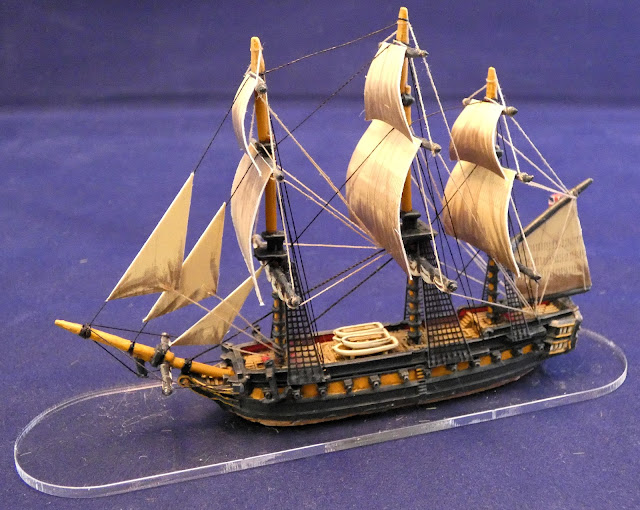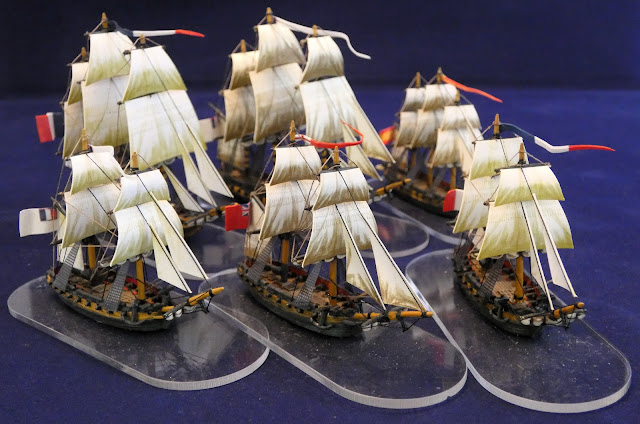 |
| A Fleet of Indiamen at Sea - Nicholas Pocock |
As mentioned in my Year End Review post, I intended to start 2025 by looking at some work I was doing before the Xmas break pulling together some collections of age of sail ships for friends and first up is a selection of four merchant ships, the East Indiamen and merchants from Warlord Games, part of Jack and Charlies collection.
 |
| Jack & Charlie's flotilla of merchantmen, two Indiamen and the two merchantmen from Warlord Games |
The use of merchantmen on the wargames table adds another strand to naval wargaming, particularly in the age of sail, before the advent of modern techniques of ship to ship communication, and further reading about the subject is always worthwhile before bringing your models to the table.
 |
| JJ's Wargames - Convoys, Roger Knight |
One such tome would be Roger Knight's 'Convoys', a book I reviewed in 2023, and one that contains a wealth of information about the issues and challenges faced by merchantmen of this era and those of the warships tasked with escorting them around the globe.
 |
| https://www.wargamevault.com/product/499498/Two-If-By-Sea |
Another interesting addition to ideas about running convoy actions on the tabletop and using Kiss Me, Hardy (KMH) and To Covet Glory (TCG) particularly for such games is Chris Stoesen's latest publication, 'Two If By Sea', who also authored TCG.
 |
| British convoy of 63 ships under attack by a Spanish squadron of 38 warships under Admiral Luis Córdova that saw just 8 ships escape. |
In it Chris offers a structure for setting up convoy actions based on the Spanish interception of a British convoy on August 9th, 1780, and extending his ideas for developing convoy actions on the North American and West Indies stations during the AWI.
The ideas presented in his game structure would be easily transferable to later periods such as the French Revolutionary and Napoleonic ones that I tend to focus on here on the blog and facilitating the use of such models shown here.
I built the Warlord merchantmen for my own collection back in 2021 and posted about those models in the link below, and those shown here are a similar variation on the theme.
 |
| JJ's Wargames - All at Sea, John Company's Indiamen |
The East Indiamen models were a later addition to the range from Warlord and I have them in my too build stock but this was the first time I had built them, and I think they are an excellent addition to the Black Seas offerings, really capturing the look of the slab-sided 20+ gun merchantmen built by the East India Company in the late 18th early 19th century and often requisitioned by the Royal Navy in the early years of the French Revolutionary War for conversion into 64-gun third rates as a stop gap until better third rates became available
,_Monmouth_(1797).jpg) |
| East Indiaman Pigot above converted to HMS Lancaster 64-guns |
The Warlord Indiaman model comes with a selection of holds amidships, some open and others closed, with the open ones showing off a hold full of goods and wares in transport.
In addition, in what would be the lower gun deck on a warship, space below the upper deck is given over to more hold-storage capacity with just the upper deck bristling with defensive armament, but it is easy to see why to the untrained eye an Indiaman might appear to be a small third or fourth rate warship, and that ruse was a useful one to maintain for these ships, particularly when considering the riches they often carried as well as very well off passengers, too and from India and the east.
The guns on an Indiaman were often lighter than those carried by a typical similarly sized warship of the period, usually 6 and 9 pounders, but with larger vessels, especially in time of war, up-gunned to 12 and 18-pounders but it would be wrong to imagine their inclusion was just for cosmetic appearances, as Indiamen were designed to be able to protect themselves from enemy naval raiders, privateers and pirates in the dangerous waters they sailed in.
That said these ships were crewed by civilian merchantmen, not naval crews subject to naval discipline, and with much smaller crews than a warship coupled with often indifferent training to handle their long guns in action, they could not be expected to fight like an equivalently sized man-of-war, but were more equipped to fend off smaller less disciplined foes such as pirates and privateers, in it for profit as their principle aim.
A typical Indiaman of this era would be the Lord Nelson, launched in late 1799. She was an East Indiaman of 819 tons bm, commanded by Captain Robert Spottiswood, armed with 26 guns (20 long 18 and six long 12 pounders), and made five voyages, of which she completed four, before her capture on her second voyage by the French privateer Bellone, later seeing the Royal Navy recapture her within about two weeks.
 |
| French ship Bellone in action with Lord Nelson 9th July 1806 - Auguste Mayer |
The Lord Nelson was on her return voyage when on the 14th August 1803 she encountered the French three-masted privateer Bellone off Cape Clear, Ireland.
 |
| Bellone versus Lord Nelson, off Cape Clear 9th July 1806 |
The Bellone, of Saint Malo, had had some success privateering in the Indian Ocean towards the end of the French Revolutionary Wars and when the Napoleonic Wars commenced she took to the sea again under the command of her former captain, Jacques François Perroud, and this was her first cruise of the new wars when she encountered Lord Nelson.
In an engagement of one and a half hours the Lord Nelson was able to fend off one attempt at boarding, but succumbed to the second, that saw Lord Nelson lose five men killed and 31 wounded, with two of the dead being passengers.
_-_(MeisterDrucke-1000413)%20a.jpg) |
| Bellone captures Lord Nelson, by Auguste Mayer |
Perroud put on board a prize crew of 41 men under the command of Lieutenant Fougie and the two vessels sailed towards La Coruña, on the north coast of Spain, but not without much drama en-route however, when on the 20th August they encountered a British frigate that saw the two vessels separated, with the frigate pursuing the Bellone rather than the Lord Nelson.
Then on the 23rd August, the British privateer Thomas and John, of fourteen 6-pounder guns, engaged Lord Nelson for two hours before breaking off the engagement.
 |
| This the second of the two Indiamen has a covered hold and boats amidships |
In the course of another day, a hired armed cutter of twelve 4-pounder guns shadowed Lord Nelson before, perhaps thinking better of tackling such a large adversary, sailing away.
 |
| HM Brig Seagull was a Diligent Class Brig of 317 tons bm and armed with sixteen 32-pounder carronades and two 6-pounder chase guns |
HM Brig Seagull, was under the command of Captain Henry Burke, and had escorted a convoy from Plymouth to Cork and was on her way back when she encountered a Portuguese schooner that reported having met with a French privateer off Cape Clear. that saw Captain Burke immediately setting out to find her.
At around 1pm on the 26th August, he sighted a large vessel and immediately set out in pursuit, and after a chase of five hours Burke was able to bring his quarry to action in an engagement that lasted throughout the night.
Daylight found Lord Nelson having expended all her cartridges in the fight and Lieutenant Fougie later informed Burke that on Seagull's next approach Lord Nelson would have struck her colours. However, Burke had to pull back to repair extensive damage to Seagull's mast and rigging, and two shot holes between wind and water.
While Seagull was undertaking her repairs Fougie's crew were able to prepare new cartridges and might have resumed the engagement when Seagull approached again, if it had not been for a British squadron under Sir Edward Pellew in the 80-gun HMS Tonnant coming into sight, with HMS Colossus 74-guns leading, that saw Seagull signal to the approaching vessels and as they came up, Fougie struck to Colossus.
In the fight Seagull had had two men killed and eight men wounded, one of whom died later, with French casualties unreported. The boats from Colossus boarded Lord Nelson where they found that five of her original crew had been serving the guns in the fight against Seagull, they protesting that they were Americans (not renegade Englishmen, and so free agents), but the prize crew put them in chains pending subsequent further investigation in Britain.
Pellew then gave Seagull the honour of escorting Lord Nelson back to Plymouth, where they arrived on the 14th September and where Seagull would undergo much necessary repairs and refitting.
 |
| The larger merchantman from Warlord sporting her archaic lateen rigged mizzen |
The East India company, with the agreement of Lloyd's Underwriters, agreed a salvage of one-sixth the value of Lord Nelson, and somewhat unfortunately for Seagull, the salvage value had not only to be shared with Colossus, but also with the other three ships-of-the-line in Pellew's squadron.
The East India Company rewarded Spottiswood with a valuable sword and a service of plate in recognition of his gallant defence of Lord Nelson.
The East India Company rewarded Spottiswood with a valuable sword and a service of plate in recognition of his gallant defence of Lord Nelson.
Alongside the two Indiamen I have put together the two merchantmen, also from the Warlord collection, one in British colours and the other flying the American merchant colours with American merchantmen often sailing in British escorted convoys when the two countries were not at war.
 |
| The smaller of the two merchantmen sporting American colours, perhaps because she is American or perhaps she is another nationality trying to evade being stopped by posing as a neutral. |
So to go with the merchantmen I have also added in a mixed group of potential marauders and escorts in the shape of two French frigates and brigs, with two in early war 1794 colours, one Spanish corvette and a British brig.
Finally my old wargaming pal Ian, who is quite keen to mess around with Kiss Me, Hardy in glorious 1:700 scale, asked me if I would put together a small collection of ships so he could have a go, and so I also completed a mix of frigates and brigs over Xmas.
Thus we have an American super frigate and small brig, a British frigate and brig and a French frigate to get things started.
So 2025 is off up and running with these collections finished and ready for delivery and with focus turning to getting my wargames room refitted before thoughts can turn towards my Nile and Algeciras project.
More anon
JJ

;_Renown_(1774)_RMG_J4062.jpg)














Gorgeous shipbuilding, Jonathan.
ReplyDeleteHi Jonathan,
DeleteHappy New Year, and thank you, I hope the chaps will enjoy playing with them.
JJ
Well, I know I sure would enjoy seeing these out on the table!
DeleteGreat, informative article and some lovely models to drool over.
ReplyDeleteWow really impressive. Love all the rigging and that looks so good,.
ReplyDeleteHi Chaps,
ReplyDeleteThanks for your comments, really appreciated, and more to come in 2025.
Cheers
JJ